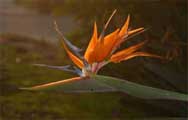
Bird of paradise (Strelitzia reginae) is a dramatic plant with distinctive iridescent orange and midnight blue flowers that resemble an exotic bird peeking out from the broad leaves in autumn, winter and spring. Although this flower is often associated with tropical places, like Hawaii, the plant is actually native to South Africa. It grows wild in the eastern Cape among other shrubs along riverbanks and clearings in the coastal bush where it is an important nectar source for birds. The climate there is mild, with rain distributed throughout the year. It has been exported throughout the world to subtropical climates. In the US it is widely used as an ornamental in Southern California and Florida – and is even the official flower of the City of Los Angeles. It is also commonly used as a cut flower in the florist trade.

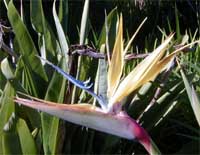
There are five species in the genus Strelitzia, named for Queen Charlotte, wife of George III, who was also the Duchess of Mecklenburg-Strelitz, Germany. They are all perennial subtropical plants native to southern Africa. In addition to the ordinary common bird of paradise, there is a variety of S. reginae with yellow sepals called ‘Mandela’s Gold’ that was was released by Kirstenbosch National Botanical Garden, Cape Town, South Africa in 1996. Although S. reginae is the most common, white or giant bird of paradise (S. nicolai and S. alba) are also available in the horticultural trade.
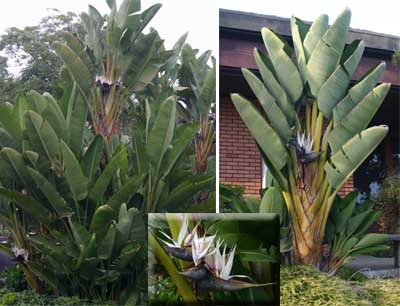
These species can grow to 30 feet tall and do not bloom until the plants are quite mature. But the large, 18-24 inch wide and 3-4 foot long, banana tree-like leaves are attractive enough on their own to make this an excellent interior foliage specimen for a very tropical look. (The common names white and giant are often used interchangeably for these two species – they look very similar, but S. nicolai usually has blue petals.) S. caudata is very similar to these two species but remains much shorter (to about 6½ feet) and is rarely available.There is also another species, S. juncea (sometimes considered a variety of S. reginae) that has a rush-like appearance, with the leaves arising from the base of the plant and staying in a round, spear-like form. This plant has flowers similar to but slightly smaller than S. reginae. It is rarely available to the home gardener.

The common bird of paradise is a slow-growing, clump-forming plant with fleshy roots. Leaves grow from a crown at the base of the plant, arising alternately (coming from the base directly opposite each other) so each clump is somewhat flattened. The leaves are borne on a long stalk that sometimes reaches up to 2 feet in length. The oblong leaf blades are stiff and leathery, concave and grayish- or bluish-green with a pale midrib.
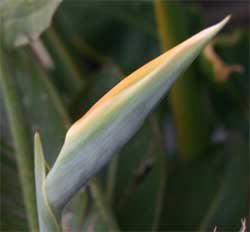
The hard, beak-like sheath from which the flower emerges is called the spathe, which grows at right angles to the stem and gives the appearance of a bird’s head. The flowers emerge one at a time from the spathe.
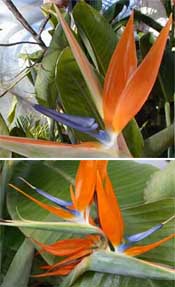
Each flower consist of 3 orange sepals and 3 blue petals. Two of the blue petals are joined together to form an arrow-like nectary. When birds that pollinate the flowers sit to drink the nectar, the petals open to cover their feet in pollen. The older flowers dry up after a while. These can be carefully removed as newer flowers emerge, to keep the bloom looking fresh, or can be left to shrivel on the flower stalk. Occasionally a second spathe will be produced from the primary one, giving a double tier of flowers.
Bird of paradise can easily be grown as a houseplant to bring a touch of the tropics to our cold climate. It needs a sunny spot indoors during the winter and does best when moved outside for the summer (but be careful to acclimate it to the stronger light outdoors or it could get sunburned). One of the most common reasons mature Strelitzia do not bloom well is insufficient light. They require nearly full sun in the summer and as much light as possible in winter to bloom. Be sure to bring the plant in before first frost (although it can tolerate a limited amount of time down to about 28ºF).
Keep the soil moist in the summer, but allow the pot to dry out between waterings when indoors. These plants are heavy feeders, so fertilize every 2 weeks throughout the summer, and monthly in the winter with a water-soluble fertilizer (if it’s planted in soilless medium; it may require less fertilizer if in real soil).

Plants tend to bloom more profusely when pot-bound, so don’t be too anxious to repot your plant once it is about 3 feet tall – just replace the top soil every year or so. Also, do not plant too deeply. Exposure of the top of the roots supposedly encourages flowering. Early spring is the best time when repotting is necessary (i.e. the roots have cracked open the pot). Plant in any well-draining soil or soilless potting mix in a large pot or tub.
Strelitzia does not have many pest problems but mealybugs, scale and spider mites may infest the plants. It is easy to wipe the large leaves off with a soft cloth (do not use any leafshine product, as that could damage the natural matte finish). Houseplant insecticides can also be used.
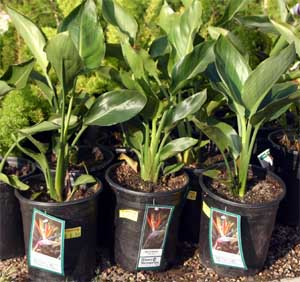
Bird of paradise can be propagated from seeds or division. Seeds are slow to germinate (it may take up to 8 weeks or more) and it will take 4-7 years for the plant to begin blooming. For best results, sow fresh seed in the spring. Soak the hard seeds for 24 hours and remove the bright orange tuft of hairs attached to the seed, then place 1 inch deep in moist potting mix and keep warm (85ºF). Transplant when the seedlings have 2-3 leaves. Grow in lower light than mature plants and do not restrict root growth, as this will slow overall development of the plant. Plants that have been blooming for a few years can be divided, but this may prevent the plant from blooming again for a few years, or young suckers can be removed from the parent plant.
– Susan Mahr, University of Wisconsin
Latest from Wisconsin Yard & Garden
Ask Your Gardening Question
If you’re unable to find the information you need, please submit your gardening question here:





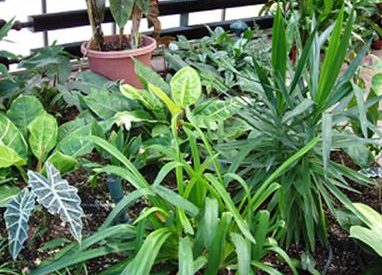 Houseplant Care
Houseplant Care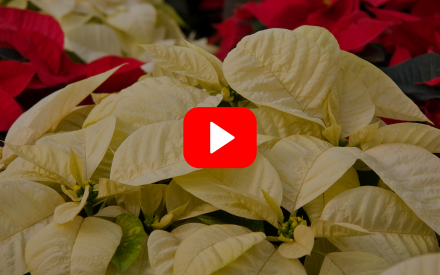 ▶ WATCH: Maintaining Your Festive Houseplants
▶ WATCH: Maintaining Your Festive Houseplants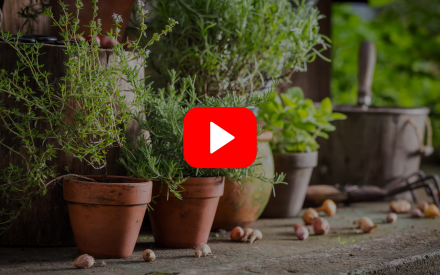 ▶ WATCH: Bringing the Garden Inside
▶ WATCH: Bringing the Garden Inside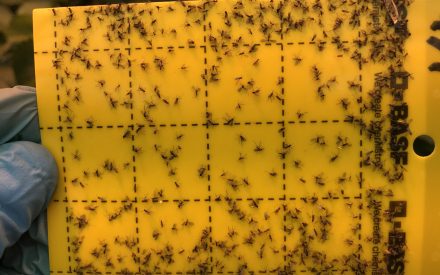 Fungus Gnats on Houseplants
Fungus Gnats on Houseplants


